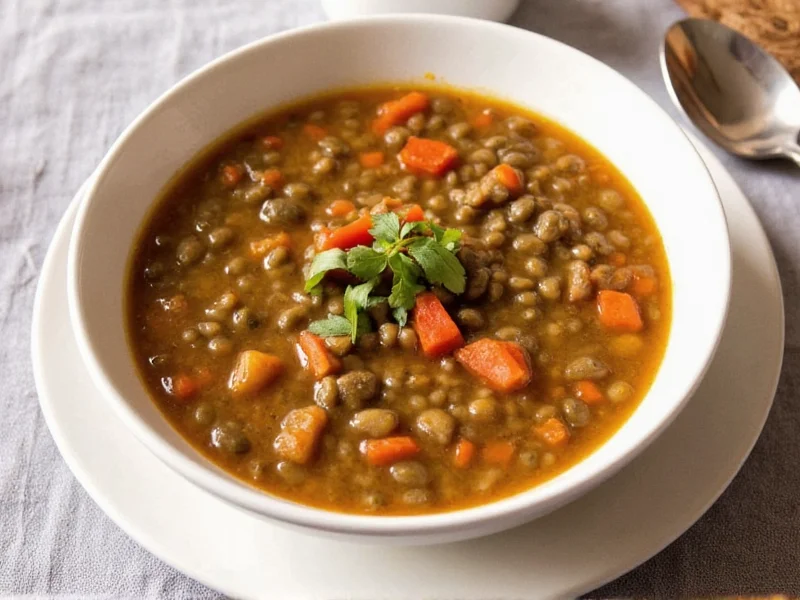Lentils are nutritional powerhouses that deserve more culinary exploration than just soup. Many home cooks don't realize how versatile these little legumes can be in creating complete meals that satisfy without requiring broth-based preparations. With their earthy flavor and meaty texture, lentils work beautifully in salads, burgers, casseroles, and even baked goods.
Why Explore Non-Soup Lentil Recipes?
Lentils provide 18g of protein and 15g of fiber per cooked cup, making them ideal for plant-based meals. Unlike soup recipes that often require lengthy simmering, many non-soup lentil dishes come together quickly while delivering complex flavors and satisfying textures. Different lentil varieties offer unique properties perfect for specific applications beyond soup:
| Lentil Type | Best For | Cooking Time | Texture After Cooking |
|---|---|---|---|
| French Green (Puy) | Salads, sides | 20-25 minutes | Firm, holds shape well |
| Beluga | Caviar substitutes, gourmet dishes | 25-30 minutes | Shiny, peppery, maintains integrity |
| Red/Yellow | Curries, dals, baking | 15-20 minutes | Soft, creamy, breaks down easily |
| Brown | Burgers, loaves, stews | 20-25 minutes | Heartier, holds shape moderately |
Five Categories of Non-Soup Lentil Creations
Lentil Salads That Impress
Lentil salads make perfect meal-prep friendly lunches that stay fresh for days. The key is using French green or Beluga lentils which maintain their structure. For a Mediterranean Lentil Salad, combine 2 cups cooked Puy lentils with diced cucumber, cherry tomatoes, Kalamata olives, red onion, and feta. Whisk together lemon juice, olive oil, garlic, and oregano for the dressing. Toss gently and refrigerate for flavors to meld. This protein-rich lentil salad recipe without soup base provides complete nutrition in a single bowl.
Hearty Lentil Burgers and Patties
The secret to non-mushy lentil burgers that hold together is using partially mashed lentils with the right binder ratio. Try this approach: Cook 1½ cups brown lentils until tender but firm. Drain well and let cool. In a food processor, pulse ½ cup cooked lentils to a paste, then mix with 1 cup whole lentils, ¼ cup breadcrumbs, 1 egg (or flax egg), grated carrot, and spices. Form into patties and pan-fry until golden. Serve on whole grain buns with avocado and sprouts for a satisfying main course that delivers 22g protein per serving.
Substantial Lentil Main Dishes
Lentil Bolognese transforms red lentils into a rich, meaty pasta sauce without any meat. Sauté onions, carrots, and celery, then add 1 cup red lentils, crushed tomatoes, vegetable broth (just enough to cover), and Italian herbs. Simmer 25 minutes until lentils break down into a thick sauce. Toss with whole wheat pasta for a hearty lentil pasta recipe that's not soup but delivers similar comfort.
Flavorful Lentil Sides and Accompaniments
Upgrade your side dish repertoire with Lemon-Herb Lentil Pilaf. Cook 1 cup French lentils in vegetable broth with a bay leaf. Fluff with fork and stir in fresh parsley, lemon zest, toasted almonds, and a drizzle of walnut oil. This elegant lentil side dish recipe without soup preparation complements roasted meats or stands alone as a light vegetarian meal.
Creative Lentil Applications
Surprisingly, lentils work beautifully in baking. For nutrient-dense lentil flour pancakes without soup ingredients, blend 1 cup cooked red lentils with 2 eggs, ½ cup milk, 1 tsp baking powder, and cinnamon until smooth. Cook on a hot griddle for protein-packed breakfasts. The lentils add moisture and structure while remaining undetectable in flavor.
Pro Tips for Perfect Non-Soup Lentil Dishes
- Rinse thoroughly - Always rinse lentils before cooking to remove debris and reduce digestive issues
- Don't oversoak - Unlike beans, lentils don't require soaking, which can make them too soft for non-soup applications
- Season late - Add salt after cooking to prevent toughening, especially important for salads and burgers
- Drain well - Excess moisture is the enemy of cohesive lentil burgers and loaves
- Acid balance - A splash of vinegar or lemon juice brightens earthy lentil flavors in salads and mains
Avoiding Common Non-Soup Lentil Mistakes
Many home cooks struggle with lentil dishes becoming mushy or lacking flavor. The solution often lies in lentil selection and cooking technique. For salads and burgers, undercook lentils slightly as they'll continue softening off-heat. When making lentil loaves, incorporate texture with chopped vegetables and nuts rather than adding excess liquid. For curry applications, red lentils work best as they naturally break down into creamy consistency without becoming soupy.
Meal Prep Friendly Lentil Solutions
Cook a big batch of lentils on Sunday for multiple non-soup applications throughout the week. Store cooked lentils in three portions: one plain for salads, one seasoned for burgers, and one with aromatics for curries. This make-ahead lentil meal prep strategy ensures you always have the foundation for quick, nutritious meals without resorting to soup every time.
Seasonal Non-Soup Lentil Inspiration
Adapt your lentil creations to the seasons. In summer, try a chilled lentil and vegetable terrine with layered roasted vegetables and herb-infused lentils. During fall, prepare a warm lentil and root vegetable shepherd's pie with mashed sweet potatoes topping a lentil and mushroom filling. Winter calls for lentil and squash stuffed peppers, while spring inspires lentil and asparagus risotto-style dishes.











 浙公网安备
33010002000092号
浙公网安备
33010002000092号 浙B2-20120091-4
浙B2-20120091-4